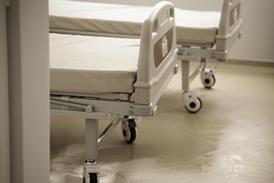Several factors have contributed to reduced emergency attendances and admissions during the coronavirus pandemic, writes Ben Owens
The last 20 years has seen a relentless and seemingly irreversible rise in demand for emergency care in the NHS, a rise which has been turned on its head in six weeks as a consequence of the covid-19 pandemic. It is our duty now to understand why and how this occurred, and to learn what lessons we can out of this crisis situation.
The impact of lockdown measures on Emergency Departments was almost immediate. Social distancing advice started in earnest in March with schools closing on 20 March and the wider lockdown starting on 23 March. ED attendances are 50 per cent down since the week of 10 March, reaching a plateau for both on 24 March since when they have been fairly steady. Admissions are down by a third, almost exactly mirroring the dates of the ED attendance reduction and the lockdown.
There are several theories as to this remarkable change in healthcare demand, and as usual the truth will most likely be a combination of all of them.
Reduction in physical contact
Firstly, most paediatric medical admissions are infection driven with schools being a likely source of transmission. With the majority of children no longer being in this environment, the likelihood of transmission has greatly reduced, and the biggest reduction in ED attendances is in paediatrics.
Minor injuries in adults and children have also dramatically reduced with the schools shut and all clubs and sports activities suspended. Along with all non-essential work stopping, and pubs and bars being closed the “opportunity” of being injured has dramatically reduced. It is logical to deduce that the reduction in injuries attending is related to this. The unknown within this is that we of course do not know how many people are choosing to manage injuries at home.
Infection prevention
Lockdown has limited social contact outside your household (except for key workers) and there has been strict advice on hand washing and two metre social distancing guidance. In addition, anyone with a temperature or a cough is being instructed to isolate with the aim to prevent the transmission of covid-19 given its high mortality and rate of infection.
These measures are not just a covid-19 prevention but an “all transmissible infection” prevention. You cannot catch norovirus, pnueumonia or flu if you don’t see anyone and wash your hands well. This will undoubtedly be leading to a reduction in respiratory, GI and other infections.
Colleagues in secondary and primary care anecdotally report improved compliance with respiratory, cardiac and diabetic medications from patients, and a record uptake in rescue medications and voluntary shielding over the weeks preceding and post lockdown. This combined with the advised 12-week strict shielding advice for these and other vulnerable groups such as the over 70s (who have a relatively higher risk of hospital admission) can only help to reduce exacerbations and therefore admissions in these patients.
Patient Choice
Advice to stay home with symptoms of covid (and other infections) such as temperature and cough rather than attending ED to be assessed in an attempt to reduce spread will have had an effect. Every ED has a number of attendances and admissions driven by chronic conditions or acute pain that does not require hospital treatment such as abdominal pain and headache. Fear of contracting covid in hospital will be keeping some of the painful but not dangerous acute or chronic illnesses who would normally attend away from the ED.
With that comes genuine concern that there are many patients out in the community not attending and are at home either dying or developing significant mortality as a result of not being treated – evidenced by a reduction in MI and stroke admissions for example.
There are cases where people with significant illness have delayed their attendance and become unwell, reporting fear of attending or because they did not want to burden the NHS when it is perceived to be under immense strain. Clinicians, Royal Colleges and the wider NHS are repeatedly sending out messages to the public asking them to attend and reassuring them that we are here to treat them and that we can keep them separate from covid. It is vital that this message continues to go out.
Shifting risk appetite
National advice about maximising the number of patients situated in community care based on seeing the risk of admission and potentially contracting covid as less than the risk of discharge has anecdotally seen a shift in the behaviour of clinicians to raise their admission threshold and more senior gatekeeping of admissions.
Other potentially contributory factors
The lack of physical exertion and work related stress may play a part as there is an increased risk of these conditions on a Monday at the start of the working week but not enough to explain the reduction.
Finally, air pollution is associated with significant mortality and increased respiratory and cardiac admissions of a non-infective cause and the lack of travel has caused record drops in pollution of up to 60 per cent in some cities.
The covid crisis has created a rapid and unique combination of injury prevention, hand hygiene, medication compliance, infection prevention, pollution and work stress reduction, keeping the sick and less sick alike away from our hospitals driven by legislation, fear and a will to protect the NHS and a change in the behaviour of clinicians and the public. This is a complex situation and we will not know the truth of this for some time (if ever) but we must strive to find out for the good of the NHS and our patients now and in the future.



























4 Readers' comments